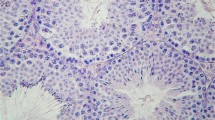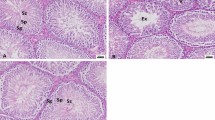Abstract
Lead acetate (LA) is a toxic compound that has detrimental effects on the male reproductive system, such as decreased testicular size and function, low androgen hormone concentration, and altered testicular histology. While Nigella sativa (NS) has been shown to possess a handful of therapeutic benefits, few studies have shown its effect on damage caused by lead acetate toxicity in the male reproductive system. In this study, 75 Sprague-Dawley rats were divided into 3 groups of 25 rats, which were further subdivided into 5 subgroups each. Group 1 (negative control) was given distilled water, group 2 (positive control (PC)) administered 10 mg/kg of lead acetate (LA) orally/daily, while groups 3 (T1), 4 (T2), and 5 (T3) were given LA 10 mg/kg and graded concentrations (100, 150, and 200 mg/kg) each of NS. One group each, comprising of 25 rats, was euthanized at days 30, 60, and 90 for collection of blood plasma, epididymis, and organ tissues fixed in 10 % buffered formalin at each time interval. The right caudal epididymis was homogenized and used for the determination of spermiogram. Plasma was used for the determination of testosterone (TS), follicle stimulating hormone (FSH), and luteinizing hormone (LH) and estradiol (EST) using radioimmunoassay kits. There was reduced number of spermatogenic cells and epididymal sperm reserves in the PC group in comparison to the treatment groups. The level of TS was lower (p < 0.05) in the PC group at 90 days, while FSH was lower (p < 0.05) in T3 at 30 days and LH was higher (p < 0.05) in T1 at 90 days. The concentration of EST was lower (p < 0.05) in the PC, T1, and T2 at all time points, while the T3 group had the higher EST concentration that was similar to the control group. There was a decreased level of superoxide dismutase (SOD) and total glutathione (GSH) in the PC group and an increased GSH level in the T3 group. Sperm concentration, viability, and motility were adversely affected by LA, while concurrent treatment with NS significantly (p < 0.05) improved these parameters. This study showed the detrimental effects of LA on spermatogenesis, TS levels, and antioxidant defenses; however, these adverse effects were alleviated by oral NS administration.







Similar content being viewed by others
References
Abba Y, HassimH HH, Noordin MM (2015) Antioxidant vitamins, oxidant injuries and diseases. PJSRR 1:58–66
Abbasnezhad A, Hayatdavoudi P, Niazmand S, Mahmoudabady M (2015) The effects of hydroalcoholic extract of Nigella sativa seed on oxidative stress in hippocampus of STZ-induced diabetic rats. Avicenna J Phytomed, 1–7
Ahamed M, Siddiqui M (2007) Low level lead exposure and oxidative stress: current opinions. CCA 383:57–64
Ali B, Blunden G (2003) Pharmacological and toxicological properties of Nigella sativa. Phytother Res 17:299–305
Allouche L, Hamadouche M, Touabti A (2009) Chronic effects of low lead levels on sperm quality, gonadotropins and testosterone in albino rats. Exp Toxicol Pathol 61:503–510
Allouche L, Hamadouche M, Touabti A, Khennouf S (2011) Effect of long-term exposure to low or moderate lead concentrations on growth, lipid profile and liver function in albino rats. Adv Biol Res 5:339–347
Al-Zahrani S, Mohany M, Kandeal S, Badr G (2012) Thymoquinone and vitamin E supplementation improve the reproductive characteristics of heat stressed male mice. J Med Plant Res 6:493–499
Awadalla EA (2012) Ameliorative effect of the crude oil of the Nigella sativa on oxidative stress induced in rat testes by cisplatin treatment. Biomedicine and Preventive Nutrition 2:265–268
Bashandy AS (2007) Effect of fixed oil of Nigella sativa on male fertility in normal and hyperlipidemic rats. Int J Pharmacol 3:27–33
Bharali M (2013) Effect of acute lead acetate exposure on liver of mice. Journal of Global Biosciences 2:121–125
Dalia M (2010) Effect of using pectin on lead toxicity. J Am Sci 6:541–554
Dorostghoal M, Dezfoolian A, Sorooshnia F (2011) Effects of maternal lead acetate exposure during lactation on postnatal development of testis in offspring Wistar rats. Iran J Basic Med Sci 14:122–131
Elgawish RAR, Abdelrazek HM (2014) Effects of lead acetate on testicular function and caspase-3 expression with respect to the protective effect of cinnamon in albino rats. Toxicology Reports 1:795–801
Elkhateeb A, El Khishin I, Megahed O, Mazen F (2015) Effect of Nigella sativa Linn oil on tramadol-induced hepato-and nephrotoxicity in adult male albino rats. Toxicology Reports 2:512–519
El-Tohamy M, El-Nattat W (2010) Effect of antioxidant on lead-induced oxidative damage and reproductive dysfunction in male rabbits. J Am Sci 6:613–622
Gali-Muhtasib H, El-Najjar N, Schneider-Stock R (2006) The medicinal potential of black seed (Nigella sativa) and its components. Adv Phytomed 2:133–153
Hala M (2011) Protective effect of Nigella sativa, linseed and celery oils against testicular toxicity induced by sodium valproate in male rats. J Am Sci 7
Ibrahim NM, Eweis EA, El-Beltagi HS, Abdel-Mobdy YE (2012) Effect of lead acetate toxicity on experimental male albino rat. Asian Pac J Trop Biomed 2:41–46
Jahromy MH, Jalili M, Mohajer AJ, Poor FK, Dara SM (2014) Effects of Nigella sativa seed extract on perphenzine-induced muscle rigidity in male mice. World J Neurosci 2014
Jesse FFA, Abba Y, Tijjani A, Sadiq MA, Konto M, Adamu L, Wahid AH, MohdAzmi ML, Eric LTC, Ab Rahman MF (2016) Gonado-hypophyseal lesions and reproductive hormonal changes in Brucella melitensis-infected mice and its lipopolysaccharides (LPSs). Comp Clin Path 25:31–36
Juma FT, Hayfaa M (2011) A: the effects of Nigella sativa oil administration on some physiological and histological values of reproductive aspects of rats. Iraqi J Vet Med 35:52–60
Krishnan N, Muthukrishnan S (2012) Effect of Nigella sativa seed extract on carbon tetrachloride-induced hepatotoxicity in rats. Acute Med 2:107–113
Mahdavi R, Heshmati J, Namazi N (2015) Effects of black seeds (Nigella sativa) on male infertility: a systematic review. J Herb Med 5:133–139
Makhlouf MMM, Eldien HMS, Zagloul DAM, Abu Dief EE, Abd ElHaliem NG (2008) The effect of the lead acetate on testicular structure and protective effect of vitamin E in adult albino rat. Egypt J Histol 31:406–418
Mann T, Lutwak-Mann C (2012) Male reproductive function and semen: themes and trends in physiology, biochemistry and investigative andrology. Springer Science & Business Media
Meyer O, Blom L, Sondergaard D (1982) The influence of minerals and protein on the nephrocalinosis potential for rats of semi synthesis diets. Lab Anim 16(3):271–273
Murugesan M, Ragunath M, Prabu T, Nadanasabapathi S, Sakthivel M, Manju V (2012a) Protective role of black cumin (Nigella sativa) on isoproterenol induced myocardial infarction in rats. Int J Pharmacol and Clin Sci 1:45–53
Murugesan M, Ragunath M, Prabu T, Nadanasabapathi S, Sakthivel M, Manju V (2012b) Protective role of black cumin (Nigella sativa) on isoproterenol induced myocardial infarction in rats. Int J Pharmacol Clin Sci 1:45–53
Mustafa H N, Hussein AM (2015) Does allicin combined with vitamin B-complex have superior potentials than α-tocopherol alone in ameliorating lead acetate-induced Purkinje cell alterations in rats? An immunohistochemical and ultrastructural study. Folia Morphol
Papanikolaou NC, Hatzidaki EG, Belivanis S, Tzanakakis GN, Tsatsakis AM (2005) Lead toxicity update. A brief review. Med Sci Monit 11:RA329–RA336
Paul F (2009) Laboratory animal anesthesia. Academic press is an imprint of Elsevier. Newcastle University, pp. 208
Salem ML (2005) Immunomodulatory and therapeutic properties of the Nigella sativa L. seed. Int Immunopharmacol 5:1749–1770
Sharma R, Garu U (2011) Effects of lead toxicity on developing testes in Swiss mice. Univ J Environ Res Technol 1:390–398
Weisbroth SH, Flatt RE Kraus AL (Eds). (2013) The biology of the laboratory rabbit. Academic Press
Yokoi K, Uthus EO, Nielsen FH (2003) Nickel deficiency diminishes sperm quantity and movement in rats. Biol Trace Elem Res 93(1–3):141–153
Acknowledgments
We want to acknowledge the Ministry of Higher Education (MOHE), Malaysia, through its Fundamental Research Grant scheme for the financial support of this research.
Author contribution
All authors contributed equally to this work.
Author information
Authors and Affiliations
Corresponding author
Ethics declarations
Ethical statement
The animal experimental protocol used in this study was approved by the Institutional Animal Care and Use Committee (IACUC) with reference number: UPM/IACUC/AUP-R047/2015, in accordance with the standard guidelines on usage and care of laboratory animals.
Conflict of interest
The authors declare that they have no conflict of interest.
Rights and permissions
About this article
Cite this article
Assi, M.A., Hezmee, M.N.M., Abba, Y. et al. Assessment of therapeutic effects of Nigella sativa against chronic lead acetate-induced reproductive dysfunction in male Sprague-Dawley rats. Comp Clin Pathol 26, 87–97 (2017). https://doi.org/10.1007/s00580-016-2349-3
Received:
Accepted:
Published:
Issue Date:
DOI: https://doi.org/10.1007/s00580-016-2349-3




